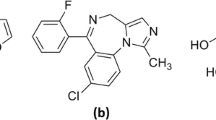Abstract
In this study, a novel molecularly imprinted polymer (MIP) was synthesized with attapulgite (ATP) and acrylamide (AM) and ethyl methacrylate (MMA) for controlled release carrier of 5-fluorouracil (5-FU). The MIPs (PAM-PMMA) were characterized by XRD, FESEM, HRTEM, and FTIR. The drug loading and in vitro controlled release ability of MIP on 5-FU was investigated by adsorption property analysis and in vitro release analysis. MIPs (PAM-PMMA) reached a maximum drug loading of 12 mg/g and a maximum release of 80% at an ATP dosage of 0.2 g (0.4%), an initial concentration of 5-FU of 100 mg/L, and an adsorption time of 240 min. Cytotoxicity analysis showed that the maximum inhibition of cells could reach 25% at 72 h of cell culture time under the above conditions. The results showed that MIPs synthesized with ATP as the substrate and AM and MMA as the functional monomers were successfully synthesized and could be used as a drug delivery system for 5-FU.
Graphical Abstract













Similar content being viewed by others
Availability of data and materials
No datasets were generated or analysed during the current study.
References
Sleire L, Førde-Tislevoll EH, Netland AI (2017) Drug repurposing in cancer. Pharmacol Res 124:74–91. https://doi.org/10.1016/j.phrs.2017.07.013
Lancet T (2023) Global cancer:overcoming the narrative of despondency. Lancet 401:10374. https://doi.org/10.1016/S0140-6736(23)00234-9
Cheng Z, Wang S, Xu S (2023) FAPI PET/CT in diagnostic and treatment management of colorectal cancer: review of current research status. J Clin Med 12:577. https://doi.org/10.3390/jcm12020577
Mahsa T, Thomas Samantha M, Sarah S (2021) Survival outcomes among patients with metastatic breast cancer: review of 47,000 patients. Ann Surg Oncol 28:7441–7449. https://doi.org/10.1245/s10434-021-10227-3
Hassanpouraghdam Y, Pooresmaeil M, Namazi H (2022) In-vitro evaluation of the 5-fluorouracil loaded GQDs@ Bio-MOF capped with starch biopolymer for improved colon-specific delivery. Int J Biol Macromol 221:256–267
Yuan Y, Xu X, Gong J (2019) Fabrication of chitosan-coated konjac glucomannan/sodium alginate/graphene oxide microspheres with enhanced colon-targeted delivery. Int J Biol Macromol 131:209–217. https://doi.org/10.1016/j.ijbiomac.2019.03.061
Oliveira D, Gomes CP, Dias RCS (2016) Molecular imprinting of 5-fluorouracil in particles with surface RAFT grafted functional brushes. React Funct Polym 107:35–45. https://doi.org/10.1016/j.reactfunctpolym.2016.08.007
**ao X, Liang S, Zhao Y (2020) Core-shell structured 5-FU@ZIF-90@ZnO as a biodegradable nanoplatform for synergistic cancer therapy. Nanoscale 12:3846–3854
Homayun B, Lin X, Choi HJ (2019) Challenges and recent progress in oral drug delivery systems for biopharmaceuticals. Pharm 11:129. https://doi.org/10.3390/pharmaceutics11:030129
Hossen S, Hossain MK, Basher MK (2019) Smart nanocarrier-based drug delivery systems for cancer therapy and toxicity studies: a review. J Adv Res 15:1–18. https://doi.org/10.1016/j.jare.2018.06.005
He S, Zhang L, Bai S (2021) Advances of molecularly imprinted polymers (MIP) and the application in drug delivery. Eur Polym J 143:110179. https://doi.org/10.1016/j.eurpolymj.2020.110179
Cunliffe D, Kirby A, Alexander C (2005) Molecularly imprinted drug delivery systems. Adv Drug Delivery Rev 57:1836–1853. https://doi.org/10.1016/j.addr.2005.07.015
Zaidi Shabi Abbas (2016) Molecular imprinted polymers as drug delivery vehicles. Drug Delivery 23:2262–2271. https://doi.org/10.3109/10717544.2014.970297
Rui L, Alessandro P (2021) Advances in molecularly imprinted polymers as drug delivery systems. Mol 26:12. https://doi.org/10.3390/molecules26123589
Mo C-E, Chai M-H, Zhang L-P (2019) Floating molecularly imprinted polymers based on liquid crystalline and polyhedral oligomeric silsesquioxanes for capecitabine sustained release. Int J of Pharm 557:293–303. https://doi.org/10.1016/j.ijpharm.2018.12.070
** X, Hu X, Wang Q (2014) Multifunctional cationic polymer decorated and drug intercalated layered silicate (NLS) for early gastric cancer prevention. Biomater 35:3298–3308. https://doi.org/10.1016/j.biomaterials.2013.12.040
Bediako EG, Nyankson E, Dodoo-Arhin D (2018) Modified halloysite nanoclay as a vehicle for sustained drug delivery. Heliyon 4:e00689. https://doi.org/10.1016/j.heliyon.2018.e00689
Dong J, Cheng Z, Tan S (2021) Clay nanoparticles as pharmaceutical carriers in drug delivery systems. Expert Opin Drug Delivery 18:695–714. https://doi.org/10.1080/17425247.2021.1862792
Ying X, Zhu X, Li D (2019) Preparation and specific recognition of protein macromolecularly imprinted polyampholyte hydrogel. Talanta 192:14–23
Prabakaran S, Jeyaraj M, Nagaraj A (2019) Polymethyl methacrylate–ovalbumin@ graphene oxide drug carrier system for high anti-proliferative cancer drug delivery. Appl Nanosci 9:1487–1500
Zhang K, Wu W, Guo K (2010) Synthesis of temperature-responsive poly (N-isopropyl acrylamide) /poly(methyl methacrylate) /silica hybrid capsules from inverse pickering emulsion polymerization and their application in controlled drug release. Langmuir 26:7971–7980. https://doi.org/10.1021/la904841m
Hassani S, Gharehaghaji N, Divband B (2022) Chitosan-coated iron oxide/graphene quantum dots as a potential multifunctional nanohybrid for bimodal magnetic resonance/fluorescence imaging and 5-fluorouracil delivery. Mater Today Commun 31:103589. https://doi.org/10.1016/j.mtcomm.2022.103589
Ponnamma D, Yin Y, Salim N (2021) Recent progress and multifunctional applications of 3D printed graphene nanocomposites. Composites Part B 204:108493. https://doi.org/10.1016/j.compositesb.2020.108493
Funding
The project is supported by the Hubei Provincial Science and Technology Innovation Team Program for Excellent Middle-aged in Higher Education Institutions (NO.T2022019) and the Hubei Minzu University Graduate Student Innovation Program (MYK2023002).
Author information
Authors and Affiliations
Contributions
X.J. wrote the main manuscript text, Z.Y. did the preparations, J.F. prepared figures and tables, and S.H. reviewed the manuscript. All authors reviewed the manuscript.
Corresponding author
Ethics declarations
Ethical approval
Not applicable.
Conflict of interest
The authors declare no competing interests.
Additional information
Publisher's Note
Springer Nature remains neutral with regard to jurisdictional claims in published maps and institutional affiliations.
Rights and permissions
Springer Nature or its licensor (e.g. a society or other partner) holds exclusive rights to this article under a publishing agreement with the author(s) or other rightsholder(s); author self-archiving of the accepted manuscript version of this article is solely governed by the terms of such publishing agreement and applicable law.
About this article
Cite this article
Ji, X., Yang, Z., Fang, J. et al. Molecularly imprinted polymers based on attapulgite and sustained-release properties for 5-FU. Colloid Polym Sci 302, 819–828 (2024). https://doi.org/10.1007/s00396-024-05237-y
Received:
Revised:
Accepted:
Published:
Issue Date:
DOI: https://doi.org/10.1007/s00396-024-05237-y



